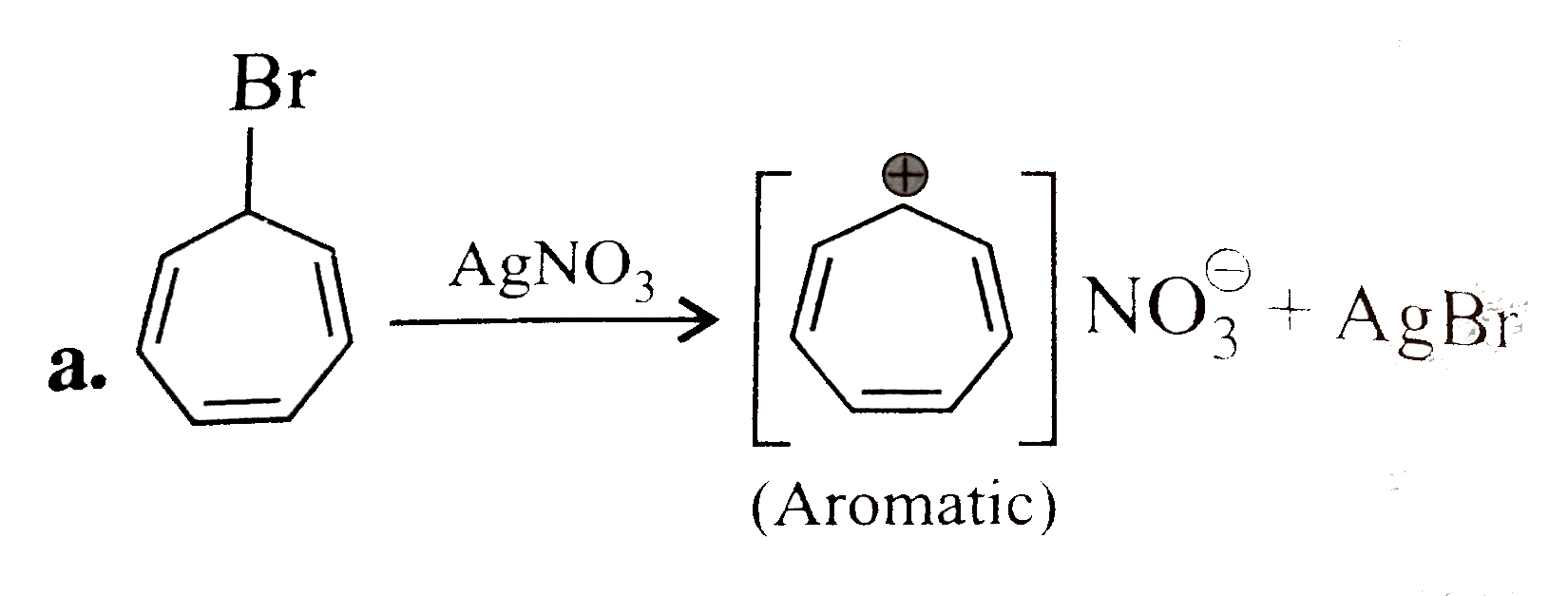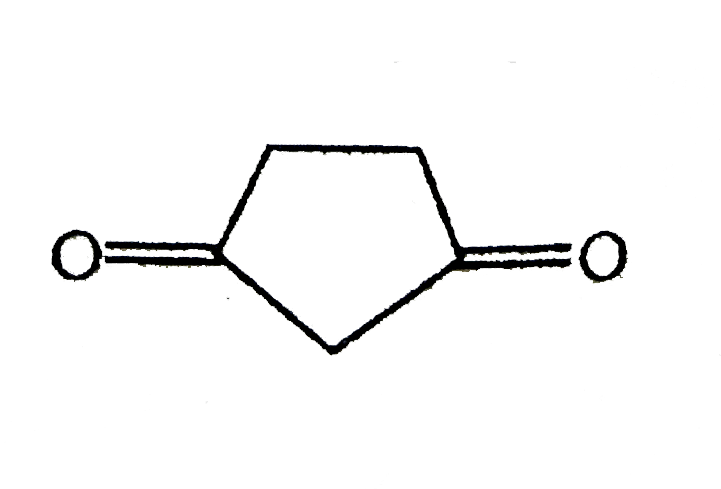Explain :
(a) An aq. Solution to troplylium bormide (C7H7Br) on treatment with AgNO3 gives a pale yellow precipitate.
(b) Cycloheptatrienyl cation has a low π -electron energy than its open-chain counterparts.
(c) Cyclo-octatetraene reacts with 2 mol of potassium to yield a stable compound.
(a),(b), and (c) are all examples of aromatic compounds.

(b) It is aromatic compound that is why it has low energy.
(c)  .
.
Topper's Solved these Questions
- ORGANIC REACTION MECHANISMBOOK - CENGAGE CHEMISTRY ENGLISHCHAPTER - ORGANIC REACTION MECHANISMEXERCISE - Subjective
19 Videos
- ORGANIC REACTION MECHANISMBOOK - CENGAGE CHEMISTRY ENGLISHCHAPTER - ORGANIC REACTION MECHANISMEXERCISE - Comprehension
35 Videos
- ORGANIC REACTION MECHANISMBOOK - CENGAGE CHEMISTRY ENGLISHCHAPTER - ORGANIC REACTION MECHANISMEXERCISE - Analytical and Descriptive
6 Videos
- NCERT BASED EXERCISEBOOK - CENGAGE CHEMISTRY ENGLISHCHAPTER - NCERT BASED EXERCISEEXERCISE - Chemical Equilibrium
73 Videos
- P-BLOCK GROUP 13 - BORON FAMILYBOOK - CENGAGE CHEMISTRY ENGLISHCHAPTER - P-BLOCK GROUP 13 - BORON FAMILYEXERCISE - Exercise Archives (Subjecive)
9 Videos
Similar Questions
(i) A powdered substance (A) on treatment with fusion mixture gives a green coloured compound (B). (ii) The solution of (B) in boiling water on acidification with dilute H2SO4 gives a pink coloured compound (C).
(iii) The aqueous solution of (A) on treatment with NaOH and Br2− water gives a compound (D).
(iv) A solution of (D) in conc. HNO3 on treatment with lead peroxide at boiling temperature produced a compound (E) which was of the same color at that of (C).
(v) A solution of (A) on treatment with a solution of barium chloride gave a white precipitate of compound (F) Which was insoluble in conc. HNO3 and conc. HCl.
Consider the following statement :
(I) Anions of both (B) and (C ) are diamagnetic and have tetradhedral geometray.
(II) Anions of both (B) and ( C) are paramagnetic and have tetrahedral geometry.
(III) Anions of (B) is paramagnetic and that of (C ) is diamagnetic but both have same tetrahedral geometry.
(IV) Green coloured compound (B) in a neutral of acidic medium disproportionates to give (C ) and (D).
Of these select the correct one from the code given :
View SolutionAn optically active compound A (assume dextrorotatory) has the molecular formula C7H11Br. A reacts with hydrogen bromide, in the absence of peroxides to yield isomeric products, B and C, with the molecular formula C7H12Br2. Compound B is optically active, C is not. Treating B with 1 mol of potassium butoxide yields (+)−A. Treating C with 1 mol of potassium tert-butoxide yields (±)−A. Treating A with potassium tert-butoxide yields D(C7H10). Subjecting 1 mol of D to ozonolysis followed by treatement with zinc and acetic acid yields 2 moles of formaldehyde and 1 mole of 1,3-cyclopentanedione.

The compound 'B' is:
View SolutionAn optically active compound A (assume dextrorotatory) has the molecular formula C7H11Br. A reacts with hydrogen bromide, in the absence of peroxides to yield isomeric products, B and C, with the molecular formula C7H12Br2. Compound B is optically active, C is not. Treating B with 1 mol of potassium butoxide yields (+)−A. Treating C with 1 mol of potassium tert-butoxide yields (±)−A. Treating A with potassium tert-butoxide yields D(C7H10). Subjecting 1 mol of D to ozonolysis followed by treatement with zinc and acetic acid yields 2 moles of formaldehyde and 1 mole of 1,3-cyclopentanedione.

The optically active compound 'A' is
View SolutionAn aromatic compound 'A' (Molecular formula C8H8O)) gives positive 2, 4-DNP test. It gives a yellow precipitate of compound 'B' on treatment with iodine and sodium hydroxide solution. Compound 'A' does not give Tollen's or Fehling's test. On drastic oxidation with potassium permanganate, it forms a carboxylic acid 'C' (Molecular formula C7H6O2), which is also formed along with the yellow compound in the above reaction. Identify A, B and C and write all the reactions involved.
View SolutionAn aromatic compound 'A' (molecular formula C8H8O) gives positive 2, 4-DNP test. It gives a yellow precipitate of compound 'B' on treatment with iodine and sodium hydroxide solution. Compound 'A' does not give Tollen's or Fehling's test. On drastic oxidation with potassium permaganate it forms a carboxylic acid 'C' (molecular formula C7H6O2), which is also formed alongwith the yellow compound in the above reaction. Identify A, B and C and write all the reactions involved.
View SolutionAn aromatic compound 'A' (molecular formula C8H8O) gives positive 2, 4-DNP test. It gives a yellow precipitate of compound 'B' on treatment with iodine and sodium hydroxide solution. Compound 'A' does not give Tollen's or Fehling's test. On drastic oxidation with potassium permaganate it forms a carboxylic acid 'C' (molecular formula C7H6O2), which is also formed alongwith the yellow compound in the above reaction. Identify A, B and C and write all the reactions involved.
View SolutionAn aromatic compound 'A' (molecular formula C8H8O) gives positive 2, 4-DNP test. It gives a yellow precipitate of compound 'B' on treatment with iodine and sodium hydroxide solution. Compound 'A' does not give Tollen's or Fehling's test. On drastic oxidation with potassium permaganate it forms a carboxylic acid 'C' (molecular formula C7H6O2), which is also formed alongwith the yellow compound in the above reaction. Identify A, B and C and write all the reactions involved.
View SolutionAn organic compound A, C8H6 on reacting with dil. H2SO4 and HgSO4 gives a compound 'B'-which can also be obtained from reaction of benzene with acid chloride in the presents of anh. AlCl3 Compound B when reacted with iodine and aq. NaOH yields C and a yellow compound D. Identify A to D with proper justification.
View SolutionAnorganic compound (A) having molecular formula C9H10O forms an orange red precipitate (B) with 2,4-DNP reagent. Compound (A) gives a yellow precipitate (C) When heated in the presence of iodine and NaOH alongwith a colourless compound (D). (A) does not reduce Tollens' reagent or Fehling solution nor does it decolourise bromine water. On drastic oxidation of (A) with chromic acid, a carboxylic acid (E) of molecular formula C7H6O2 is formed. Deduce the structures of the organic compounds (A) to (E ).
View SolutionAnorganic compound (A) having molecular formula C9H10O forms an orange red precipitate (B) with 2,4-DNP reagent. Compound (A) gives a yellow precipitate (C) When heated in the presence of iodine and NaOH alongwith a colourless compound (D). (A) does not reduce Tollens' reagent or Fehling solution nor does it decolourise bromine water. On drastic oxidation of (A) with chromic acid, a carboxylic acid (E) of molecular formula C7H6O2 is formed. Deduce the structures of the organic compounds (A) to (E ).
View Solution
